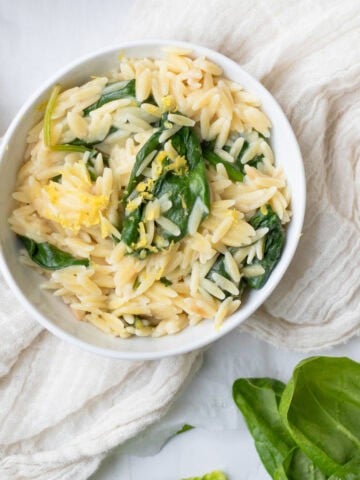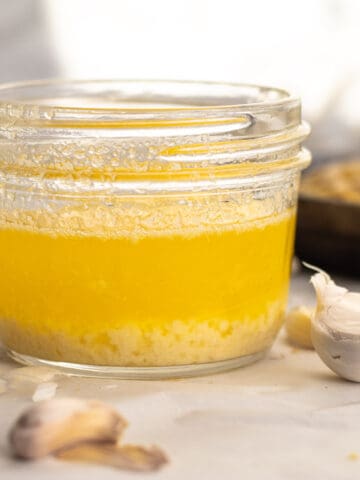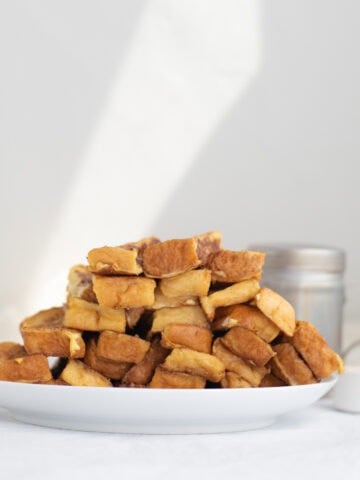I still dream about the pesto we had in Florence, stumbling into a little neighborhood trattoria after sleeping in (thanks, jet lag) and ordering a dish that was so simple but absolutely perfect. That classic pesto was bright, garlicky, and packed with fresh basil flavor, and I’ve been chasing that taste ever since.
While I may not have an Italian trattoria around the corner, I do have a blender and a few pantry staples, which is all you need to make this 5-minute basil pesto at home.
With just six ingredients, this easy pesto recipe comes together in minutes and instantly makes anything taste better. Toss it into a creamy pesto pasta dish, spread it on sandwiches, or slather it on fish and make pesto salmon, the possibilities are endless.

Ingredients

- Basil: Fresh is best. In a pinch you can use the frozen basil cubes, but you'll need a lot of them. Instead, I would suggest swapping the basil for spinach and making spinach pesto instead.
- Pine Nuts: Pine nuts can be expensive, but are totally worth using. To extend the life of your open bag of pine nuts, store them in the freezer. This helps the oils in the nuts from going rancid.
- Parmesan cheese: If you have a chunk of Parmesan cheese in your fridge, you can definitely grate it fresh. Use the fine side of your grater. If you want to keep things simple, you can buy grated Parmigiano-Reggiano. Just don’t use the shelf stable green can of Parmesan for this. You want the real deal.
- Garlic: Fresh is great if you have it on hand or use the frozen cubes (2 does the job), which I highly recommend stocking in your freezer at all times.
- Olive Oil: I like extra virgin olive oil and the one I use has a peppery finish. Use what you like. You want an olive oil that tastes good on its own for this recipe.
Buy a basil plant: I recommend buying a small basil plant in the spring each year and using it for all your basil needs throughout the summer. If you plant it outside, it’ll will grow big and produce a ton of leaves as long as you keep picking them.
Make the pesto

Put the cheese, garlic and pine nuts into your blender (I used my Vitamix) or a food processor and blend till well combined.

Add the basil to the blender container and the stream in the oil while you blend the pesto together

Use immediately in any recipe calling for pasta.

Or store it for later in your fridge or freezer.
While basil pesto is the classic recipe I think of when I hear the word "pesto", the above is really just the method for making all sorts of pesto. Try swapping out the greens, the nuts and the cheese for endless combinations of deliciousness.
- Basil swaps: Spinach pesto is a go to and broccoli, kale and arugula pestos are all great options.
- Pine nut swaps: Guys, the nut choice are truly endless. Try pistachios, cashews, walnuts, almonds and for a nut free pesto, sunflower seeds.
Serving suggestions
- With pasta: The pesto is a great base for lots of pasta recipes. The basic method is to cook pasta as you like, reserving about ½ cup cooking water before draining. Add pesto and a splash of pasta cooking water and stir together. You can also use in to make gnocchi with pesto or a pesto pasta salad with mozzarella balls.
- On toast or a sandwich: Smear basil pesto on toast (crunchy sourdough is what we like best) and top with a few extra pine nuts and a sprinkle of cheese. Or use it as a spread in a classic caprese sandwich.
- As a flavor enhancer: Add a spoonful of pesto to any recipe you want to a give a little something extra, try it in basil corn soup or with a lemon butter pasta.

Make ahead and freeze
Make a double batch, you’ll thank me. And at the end of the summer when basil is in abundance in the garden, I make a bunch of batches to freeze and use all winter long.
- Store in fridge: The pesto will stay good in the fridge for up to a week. When you are ready to use it, just take it out and enjoy!
- To freeze: Portion into either 4oz mason jars or silicone ice cube trays. Press plastic wrap right onto the pesto to prevent it from changing color. The 4oz jars are the perfect ½ cup amount you'll need for most recipes.
- When you are ready to use: Defrost on the counter at room temperature for about an hour before using.

Pasta recipes this pesto pairs well with
Did you try this recipe and and love it? 😍 Let me know by leaving a comment below or 5 ⭐ rating!
And make sure to sign up for my newsletter and follow along on Instagram, Pinterest, and Facebook for more simple recipes! Remember to tag us on social channels when you make a recipe at #simplegraytshirt! I 💖 seeing what you’re up to in the kitchen!
📖 Recipe

5-Minute Basil Pesto
Equipment
Ingredients
- ½ cup pine nuts
- ¼ cup grated parmesan cheese
- 1 cloves garlic
- 1 teaspoon salt
- 2 cups packed basil leaves (washed and gently patted dry)
- ½ cup olive oil
- ½ lemon, juiced (optional)
Instructions
- Put pine nuts, garlic, Parmesan and salt into a high speed blender or food processor. Blend on medium speed until ingredients are mostly combined.
- Add basil and blend until just broken down, then stream in olive oil with blender on low. Add lemon juice at this point if using.
- Blend on medium to desired consistency (I like mine on the smoother side). Once done, store for later or use in your favorite recipe.
Notes
-
- Store in fridge: The pesto will stay good in the fridge for up to a week. When you are ready to use it, just take it out and enjoy!
-
- To freeze: Portion into either 4oz mason jars or silicone ice cube trays. Press plastic wrap right onto the pesto to prevent it from changing color. The 4oz jars are the perfect ½ cup amount you'll need for most recipes.
-
- When you are ready to use: Defrost on the counter at room temperature for about an hour before using.
- Ways to use the pesto: On pesto salmon, in creamy pesto gnocchi, spread on sandwiches or dolloped into soup.











Matt | Total Feasts says
Great recipe, I love fresh pesto with my gnocchi. So much better homemade than from the shop, you know the quality of everything you put in!